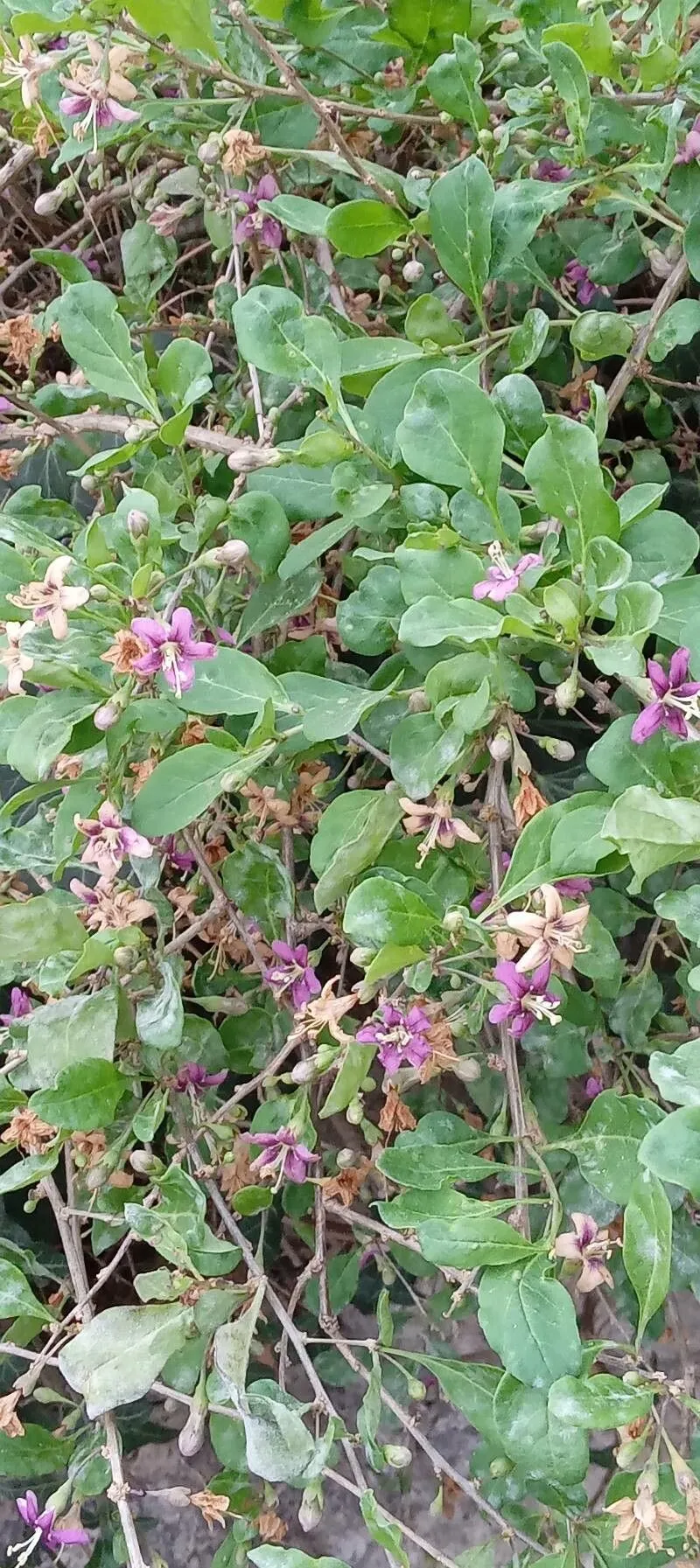
Author: Mill.
Bibliography: Gard. Dict. ed. 8: n.º 5 (1768)
Year: 1768
Status: accepted
Rank: species
Genus: Lycium
Vegetable: False
Observations: China to Temp. E. Asia
The Chinese boxthorn, scientifically known as Lycium chinense, is a species belonging to the family Solanaceae. This resilient plant is native to China and Temperate Eastern Asia, where it thrives in varied climatic conditions, from the warmer regions to the temperate zones.
Characterized by its thorny nature, the Chinese boxthorn is a deciduous shrub that can reach a height of up to 1-3 meters. The plant is well-recognized for its woody stems adorned with slender, pointed thorns. The leaves of Lycium chinense are simple, lanceolate to ovate in shape, and typically bright green, contributing to the ornamental appeal of the shrub.
One of the most renowned attributes of the Chinese boxthorn is its small, tubular flowers, which can be white to light purple. These blossoms emerge during the growing season and eventually give way to the plant’s distinctive red to orange-red berries. These berries, commonly referred to as goji berries, are highly valued not only for their vibrant color but also for their numerous health benefits.
In traditional Chinese medicine, the berries of the Chinese boxthorn are prized for their therapeutic properties. They are known for their potential to improve vision, boost immune function, and provide a rich source of antioxidants. The leaves and roots of the plant are also occasionally used in herbal remedies, demonstrating the plant’s significant role in traditional healthcare practices.
Cultivating Lycium chinense requires well-drained soil and a position with full sun to partial shade. It is a hardy plant that can tolerate a range of soil conditions, although it thrives best in fertile, well-irrigated environments. Gardeners often appreciate the plant for its minimal maintenance needs and its ability to attract beneficial insects, making it an excellent addition to both ornamental and functional garden landscapes.
The historical context of the Chinese boxthorn’s classification dates back to 1768, as noted in Miller’s Gardener’s Dictionary. This documentation exemplifies the long-standing recognition of the plant’s significance in botanical studies.
Overall, the Chinese boxthorn stands out not only for its horticultural and medicinal values but also for its cultural relevance and the ease with which it can be incorporated into various garden settings. Whether appreciated for its aesthetic properties or its healthful berries, Lycium chinense is a plant of considerable importance.
Dan: bredbladet bukketorn
Eng: chinese teaplant, chinese boxthorn, chinese desert-thorn, chinese matrimony-vine, chinese wolfberry, wolfberry, chinese matrimony vine, chinese box-thorn
Deu: chinesischer bocksdorn
Fra: lyciet de chine
Ita: spina santa cinese
Swe: bredbladigt bocktörne
Por: cambroeira-da-china
Ind: daun koki
Msa: kaukichai
Nno: kinabukketorn
Nob: kinabukketorn
Ces: kustovnica, kustovnice
Hun: kínai ördögcérna
Nld: chinese boksdoorn
Cym: bocys ddrain, bocys pigoglyn, ysbeinwydd, ysbeinwydd tsieina, ysbeinwydden tsieina
En: Chinese boxthorn, Chinese wolfberry, Wolfberry, Chinese matrimony-vine, Chinese teaplant, Chinese desert-thorn, Chinese tea-tree, Chinese matrimony vine, Chinese box-thorn, China Teaplant, Chinese Wolf-berry, Gou qi, Kuko
Hy: Հազազ չինական
Az: Cin itüzümü
Zh: Gou qi, 枸杞
Cs: Kustovnice čínská, Kustovnica, Kustovnice
Da: Bredbladet bukketorn
Nl: Chinese boksdoorn
Fi: Kiinanpukinpensas
Fr: Lyciet de Chine
De: Chinesischer Bocksdorn, Chinesischer Teufelszwirn
El: Λύκιο το σινικό
Hu: Kínai ördögcérna
Id: Daun koki
It: Spina santa cinese, Spina-santa cinese
Ja: Kuko
Ko: Gugija, Gugijanamu, 구기자나무
Ms: Kaukichai
Nb: Kinabukketorn
Nn: Kinabukketorn
Fa: لیسیوم چینی
Pl: Kolcowój chiński
Pt: Cambroeira-da-china
Sk: Kustovnica čínska
Es: Cambronero chino
Sv: Bredbladigt bocktörne
Zh-tw: 枸杞
Cy: Ysbeinwydden Tsieina, Bocys Ddrain, Bocys Pigoglyn, Ysbeinwydd, Ysbeinwydd Tsieina
Taken Sep 6, 2003 by Andrzej Konstantynowicz (cc-by-sa)
Taken Sep 23, 2022 by Fabrice Rubio (cc-by-sa)
Taken Sep 23, 2022 by Fabrice Rubio (cc-by-sa)
Taken Oct 5, 2022 by Fabien Chalumeau (cc-by-sa)
Taken Sep 6, 2003 by Andrzej Konstantynowicz (cc-by-sa)
Taken Sep 23, 2006 by Tela Botanica − Mathieu MENAND (cc-by-sa)
Taken Aug 23, 2022 by Mátyás Hegedüs (cc-by-sa)
Taken Sep 23, 2022 by Fabrice Rubio (cc-by-sa)
Taken Jul 14, 2013 by Tela Botanica − George FOWLER (cc-by-sa)
Taken Sep 23, 2022 by Fabrice Rubio (cc-by-sa)
Taken Aug 12, 2022 by azur81 bleu (cc-by-sa)
Taken Sep 23, 2022 by Fabrice Rubio (cc-by-sa)
Taken Aug 12, 2022 by azur81 bleu (cc-by-sa)
Taken Jun 23, 2021 by Christine D (cc-by-sa)
Taken May 16, 2017 by Pierre Bonnet (cc-by-sa)
Taken Aug 29, 2020 by Ruddy BENEZET (cc-by-sa)
Taken Sep 11, 2022 by Bogdan Nesic (cc-by-sa)
Taken Sep 14, 2022 by gomez toni (cc-by-sa)
Taken Sep 21, 2022 by Claudiu Roman (cc-by-sa)
Taken Sep 6, 2003 by Andrzej Konstantynowicz (cc-by-sa)
Taken Sep 15, 2005 by Photoflora – Benoit BOCK (©)
Taken Aug 15, 2012 by Photoflora – Benoit BOCK (©)
Taken Jan 1, 1970 by Photoflora – L’Abbé COSTE (©)
Taken Jul 31, 1854 by Tela Botanica − Herbier PONTARLIER-MARICHAL (cc-by-sa)
Taken Jul 14, 2013 by Tela Botanica − George FOWLER (cc-by-sa)
Taken Oct 24, 2021 by Sylvain Piry (cc-by-sa)
Taken Aug 23, 2022 by Mátyás Hegedüs (cc-by-sa)
Growth habit>: Shrub, Vine
Ph maximum: 7.0
Ph minimum: 6.5
Light: 8
Atmospheric humidity: 5
Soil nutriments: 5
Family: Myrtaceae Author: (F.Muell.) K.D.Hill & L.A.S.Johnson Bibliography: Telopea 6: 402 (1995) Year: 1995 Status:…
Family: Rubiaceae Author: Pierre ex A.Froehner Bibliography: Notizbl. Bot. Gart. Berlin-Dahlem 1: 237 (1897) Year:…
Family: Sapindaceae Author: Koidz. Bibliography: J. Coll. Sci. Imp. Univ. Tokyo 32(1): 38 (1911) Year:…
Family: Asteraceae Author: A.Gray Bibliography: Pacif. Railr. Rep.: 107 (1857) Year: 1857 Status: accepted Rank:…
Family: Fabaceae Author: Medik. Bibliography: Vorles. Churpfälz. Phys.-Ökon. Ges. 2: 398 (1787) Year: 1787 Status:…
Family: Aspleniaceae Author: (Cav.) Alston Bibliography: Bull. Misc. Inform. Kew 1932: 309 (1932) Year: 1932…